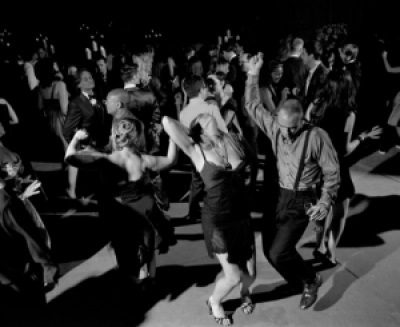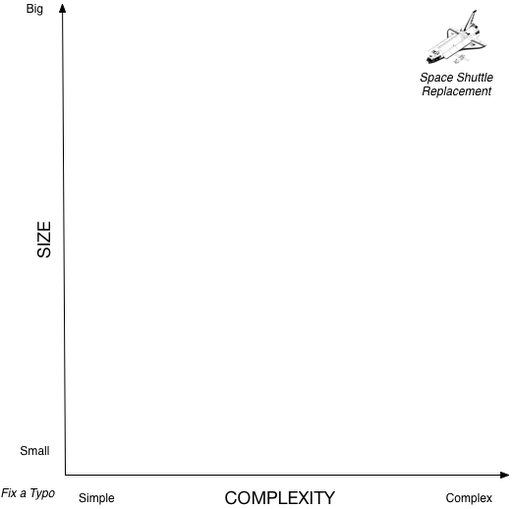I’m interested in the metaphors we use to describe being in uncertainty and I think you should be too. Have you ever noticed how we describe, in the vernacular, our actions when facing uncertainty. I’m exploring these stories because I think, more than we are actively aware, humans engage uncertainty, rather effectively, quite regularly. It is only when we stop and try to think about how we actually grapple with uncertainty that we seem to become paralyzed by an inability to remember… “How did I figure out what to do when I didn’t know what to do?” Often when I ask people to describe the last time they didn’t know what to do, they’ll admit to facing uncertainty, but have a difficult time describing specific experiences of how they decided to take action while facing uncertainty.
So, I collect these clues, in the hopes that I can use them to remind people of what is that uncertainty feels like, and bring them back to a specific moment of uncertainty.
One of the clues I’ve noticed is the phrase “Collect your thoughts.” It took me ages to understand how self-explanatory this phrase is. I always assumed that there was something more to “Collecting your thoughts” than, observing what I was thinking and selecting specific thoughts I found interesting for further consideration.
Think of the last time you heard the phrase, or said it aloud… “I need a moment to collect my thoughts” (Tell me a story about it in the comments!). For me, when I reflect on times I have heard or said “collect my thoughts”, those were times when the world around me was a bit out of control. The phrase echoes a sense of “needing time to think.”
I remember talking to a friend on September 11th, whose father may or may not have been in the towers, we couldn’t know, the phones didn’t work. “I need a moment to collect my thoughts” she said, hands on her head looking down at the ground.
Wiktionary’s definition of the phrase seems to echo these ideas:
To become mentally composed, especially after being distressed, surprised, or disoriented; to become calm or organized in one’s emotional state or thinking, as in preparation for a conversation, speech, decision, etc.
These moments of distress, surprise and disorientation are particularly difficult to dispassionately observe. Humans in these situations seem to become so deeply involved in reacting when disoriented, the fight or flight mind taking over, that they have a hard time being reflective about the experience. This short circuiting of dispassionate observation is unfortunate (unless you are facing a tiger) because we also have a hard time disambiguating life threatening uncertainty… and normal everyday stressful uncertainty.
The problems with this lack of reflection in critical moments are seen in the definition as well. We “collect our thoughts” in preparation for conversation, speech and critically decision-making. Surely we need to be most aware of our critical thinking while making stressful decisions. And yet so often we can’t remember how it is that we made these decisions.
Now that we have noticed, we might find some value in trying to think clearly about how one might collect thoughts, so we are able to more deliberate in future moments of uncertainty.
To begin with, what is collecting? Collecting is a process, an activity, by which we modify a collection. As we collect we change the quality of the collection itself… it may grow, or maybe we have to make space by removing older objects. The act of collecting is the act of changing what we have collected.
Collections can be personally, professionally, or socially important. We also say that abstract sets of similar types are collections, such as Arrays in software engineering.
One way we collect is to decide to preserve a class of things based on a subjective set of qualities. We don’t collect any sea shell, we collect those worth preserving. We add those that we deem worthy of preserving to a collection or set of sea shells, leaving those we decide are not collectible behind. In this way collecting could be seen as a form of applying a set of values towards a set of options in order to select those options worth keeping.
Then there is collecting of collections that have value beyond personal judgements. The collection of things that are considered by a group to be more valuable as “completed” collections. Baseball cards, stamps and butterflies. The completed set seems to talk about the order that could be found in the world. That there are categories and places for each things, a great shared taxonomy.
Collecting can also be thought of as the act of not selecting but simply capturing each possible instance of a certain set. There are for example those who hoard their thoughts. Robert Shields, for instance, left at his death in 2007 a diary of 37.5 million words. He spent four hours each day, collecting his thoughts and observations of his bowel movements, for each five minutes period of his days.
Obsessive collecting can also point in another way… towards the edges of a set, an attempt to find the point at which a concept diffuses into simple noise. Here one might think of Claes Oldenburg’s Ray Gun Wing, with its collection of ray guns, as well as objects and images that share a resemblance to ray guns, in whole or simply in profile. An invitation by the artist to explore the form of a Ray Gun, and what we might think of as form and belonging.
Collecting can also be seen as a kind of clearing the away or gathering together, after a fragmenting, fracturing or scattering of something once whole. Clearing away the shards and scattered pieces of a broken glass after accidentally dropping it on a hard surface.
Related but qualitatively different would be the collecting of pieces to put them back in order. There is no hope for reassembling a broken glass, but there are things we need to collect to simply begin the process of repair. Picking up pieces of a valuable vase that we’ll try to glue back together, or the pieces of a broken heart. This is a collecting with the intent of returning the pieces together.
We also need to understand, what are the thoughts that we are collecting in moments of uncertainty. Observed, they are not vague and unformed, but often more fragmentary and contradictory. The confusion of uncertainty comes less from a fog of impalpable nebulosity, and more in the form of a buzzing swirl of specific thoughts. Observed carefully uncertainty often feels like an overwhelming set of options, what is lacking isn’t the structure of the thoughts or a limited number of options, but a structure for sorting them. Uncertainty is in the end an inability to decide clearly what it is we value and wish to keep and what it is we don’t need to take with us now, and choose to leave to be rediscovered by another day or person.
In this way, collecting our thoughts isn’t just about each thought that is selected. It is co-evolutionary, each thought modifying, amplifying or dampening those we have previously selected, changing not just the thoughts themselves but the quality of the collection in whole.
Collecting our thoughts then maybe about creating a dynamic balance, not a just goal state or a static defensible position. Collecting out thoughts is then a transitional strategy for moving through uncertainty with a sense of centeredness. A way of moving from uncertainty toward clarity and order, even if we find that clarity temporal or transitory.
Here to we can observe that this observing of thoughts to center ourselves is different than the centering of Mindful Meditation. In meditation we observe our thoughts in attempt to release them, to acknowledge our human nature and to simply be. This being, being present and in the moment, it quite different than what we wish to achieve when we collect our thoughts. In collecting our thoughts we are concerned not only with being, but with becoming. We collect our thoughts to move forward and to act.
We collect our thoughts to rebalance and find our way by reaffirming decisions based on new information and to evaluate new ideas and options. We collect our thoughts to consider anew based on a new balance.
I start most of my writing projects because I don’t know about something.
-Gerald M. Weinberg
Take for instance Robert Frank, collecting images for The Americans. When we collect images from an uncertain world, we collect without knowing the final form a collection will take. We don’t enter the world with a check list of images to make, but with the belief that the images we make will come to make sense. Each successful image begins to hint at other images we may need to watch for in the world and so the photographer and the collection of photographs interchange desire and agency.
One way we can use these ideas is to generalize the practice of collecting our thoughts in extreme uncertainty, to less critical forms of trying to make sense of our world. Almost certainly we are broadly confronted with uncertainty as an inherent part of the human condition, even if we have difficulty recognizing it.
As a first step, we could recognize some of the ways in which we experience uncertainty. The feeling of uncertainty is often a feeling of having too many thoughts or options, being unable to decide, or lacking a structure to make a confident decision. In this way many options appear equally valid and yet we feel as though we must choose to eliminate some. Another way in which we experience uncertainty is when something we observe doesn’t fit our categories or models, should we modify our understanding or the idea itself? Finally, we can observe that uncertainty and the embrace of the liberation of “not knowing in advance” is the heart of creative endeavors… we can observe that when we feel creative and in “flow” we are fully engaged in acting in the world.
There are some practices that I have observed for directly engaging in collecting your thoughts… you may find them rewarding.
Take Jerry Weinberg’s lovely idea of collecting our thoughts like we collect field stones. We observe the quality of our ideas, ones that we particularly enjoy and have a powerful emotional reaction to. We pile them together so that in the future as we wish to make stone walls, we simply need to fit together a selection of the field stones we have found. In this way collecting our thoughts in not about a current final ordering, it is a collecting for future ordering. A collecting as sorting… Jerry describes these practices in detail in his book “The Field Stone Method”
Jim Benson and Tonianne DeMaria Barry also suggest collecting thoughts for another purpose. Collecting and externalizing thoughts allows room in our minds to think. Like clearing away space, or removing stones from a field, collecting our thoughts lowers our existential overhead. This process of collecting and externalizing thoughts has been useful to many people for rebalancing their lives and making decisions about how to move forward. Jim and Toni describe their ideas in detail in: Personal Kanban
——————————————————————
We’d Like to Collect Your Thoughts…
These thought were inspired by my attempts to think about micro narratives and journaling as a sense making activity. If you would like to learn more feel free to ask me.
If you would like to participate in a sense making research project based in micro narrative journaling, The Lean System Society (and I) would appreciate your contributions to our research project… You can find out more http://us.sensemaker-suite.com/Collector/collector.gsp?projectID=LSSReactor2013&language=en#Collector
By contributing you can help us complete some research into the hidden and underlying realities of systems work. Most individuals have a myriad of good and bad stories about working with and inside systems. You can help the LSS conduct this important and unprecedented research by simply sharing those stories.
Please contribute you stories here: http://us.sensemaker-suite.com/Collector/collector.gsp?projectID=LSSReactor2013&language=en#Collector
Your stories will be used in sense-making exercises at the LSS’s Reactor 2013 conference. If you contribute stories to the research project you will be able to request a summary report of the results.
Because the sense-making exercises leverage diverse and divergent view points to better understand the nature of system’s work, the quality of the research will be based on 2 quantities; The quantity of unique view points (different individuals) and the quantity of stories contributed.
You can do two things to go above and beyond helping us with this project…
1) Use the sensemaker site as an active journaling system for the next 5 days. Spend 10 minutes at the end of the day collecting your thoughts and reflecting on your experiences here: http://us.sensemaker-suite.com/Collector/collector.gsp?projectID=LSSReactor2013&language=en#Collector
If you use a kanban system like I do, I find processing the tickets in my kanban “done” column to be a nice mediative practice. It allows me to clarify what I have done, what I am capable of, and the ways in which I observe myself improving.
2) Please consider sharing this post… or write an email in your own words, to other individuals you think may enjoy the exercise of journalling and may like to contribute to the research. Or you might consider writing about your experience using the system on your blog or twitter and providing a link back to the system.
I’d like to personally thank you for contributing if you choose to do so. I know that each of you have a useful contribution to make, Thank you.
The LSS is dedicated to improving the economic and sociological outcomes of the world’s systems. You can find out more at the LSS website here: http://leansystemssociety.org/










































Scuttlebut